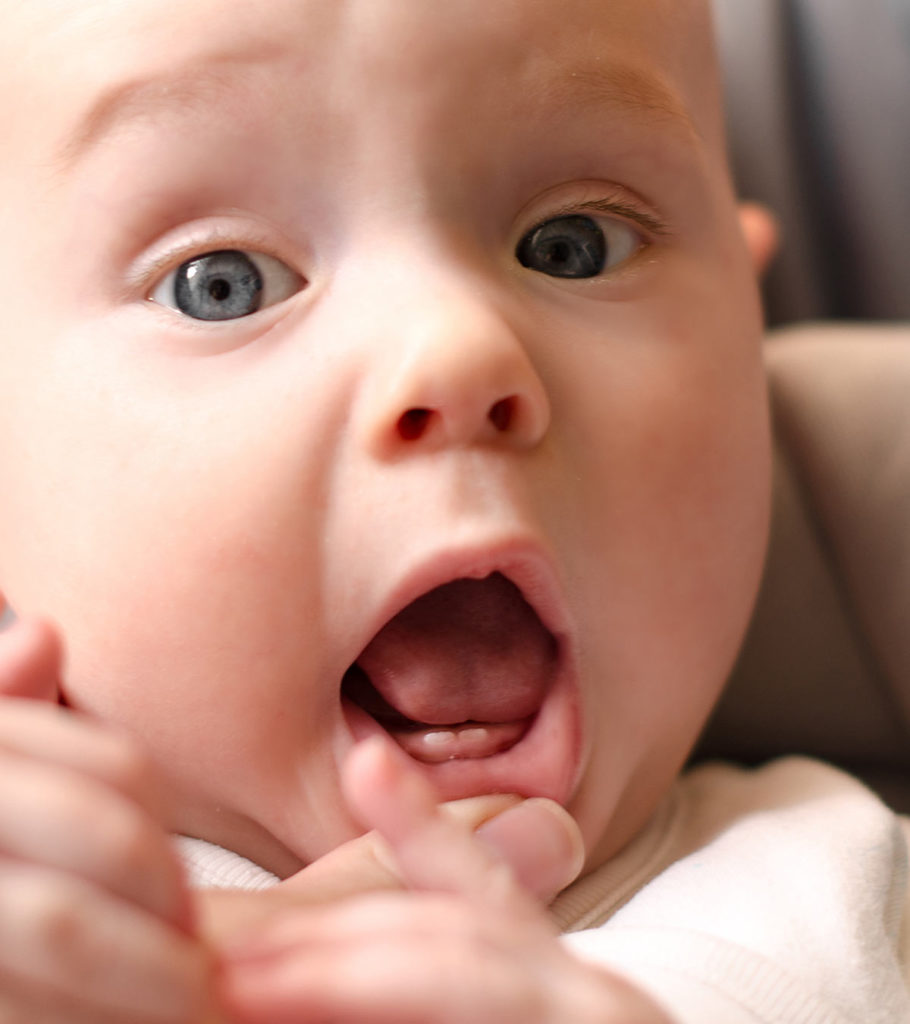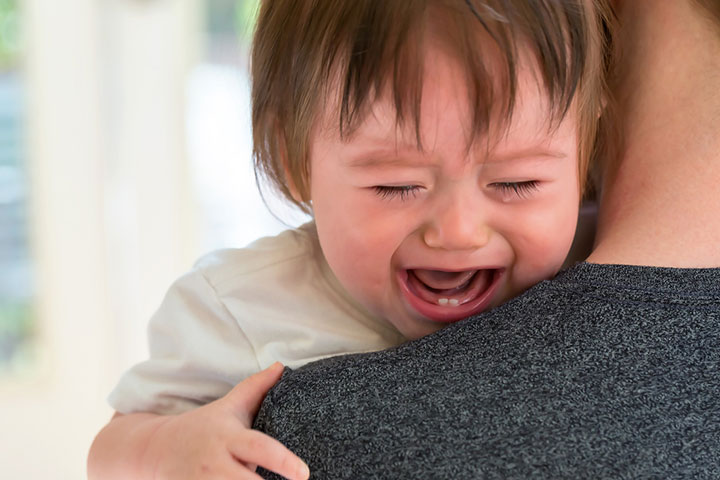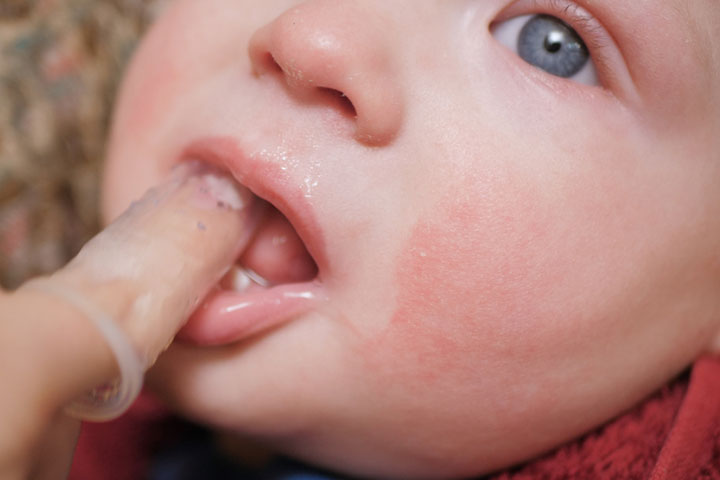Teething is the growth of teeth through the gums that begins in infancy and continues into toddlerhood. However, teething in toddlers is not the same as it is in babies; the symptoms are distinct and must be addressed accordingly. The process of teething usually completes between the ages of one and three, so you might wonder, “what teeth does a toddler get?” and “how do you manage your baby’s teething symptoms at the time?” This post discusses everything about teething, including the normal teething order in toddlers and ways to deal with teething pain and other symptoms in toddlers.
Teething Order In Toddlers
Below is the toddler teething chart between the ages of 12 and 36 months (1):
| Age | Teeth |
|---|---|
| 10-16 months (Average age – 11.5 months) | Lower lateral incisors |
| 9-13 months (Average age – 12.4 months) | Upper lateral incisors |
| 17-23 months (Average age – 18.2 months) | Lower canines |
| 16-22 months (Average age – 18.3 months) | Upper canines |
| 23-31 months (Average age – 26 months) | Lower second molars |
| 25-33 months (Average age – 26.2 months) | Upper second molars |
Here is what the teeth will look like in the mouth:
A total of 20 primary teeth erupt by the time your toddler is three years old (2). So when toddlers get the upper second molars, their primary teeth emergence is complete.
Note that the sequence in which the teeth erupt may differ from child to child. So don’t worry if your child’s sequence doesn’t match this one. However, the teeth should erupt properly and fully.
What If The Teeth Do Not Erupt Properly?
The following conditions can lead to teething problems in toddlers:
- Dental caries: A pool of milk can accumulate in the mouth of the toddler when he/she sleeps with formula or milk bottle. Natural sugars from milk can accumulate within the gums and cause cavities and tooth decay. These are called nursing bottle caries (3), and may also develop when the toddler sleeps with the breast nipple in the mouth (4).
- Congenital teeth disorders: Several congenital disorders could affect teething in toddlers. An example is hypodontia, a condition where the toddler has a few missing primary teeth (5). In some very rare cases, the toddler may not have teeth at all, a condition that is called anodontia (6).
If you suspect that the toddler’s teeth are not erupting as per schedule, then take the baby to the doctor right away. You will know whether or not the teeth are coming out correctly when you identify the signs and symptoms of teething.
What Are The Symptoms Of Teething In Toddlers?
You will know the toddler is sprouting some teeth when you see the following signs (7):
- Irritability:Perhaps the leading signs of teething in a toddler are mood swings and irritability. The toddler would become fussier and even throw tantrums more than usual.
- Changes in behavior: Small things would upset the toddler easily. Some toddlers may also display a complete shift in temperament, leaving the parents confused.
- Irritation in the gums: Gums may appear inflamed and would always be sore. Older toddlers may point towards their mouth to indicate that they have irritation in their gums.
- Trouble falling asleep: A teething toddler will have difficulty falling asleep, and even if they do, they will have disturbed sleep or sleeplessness. The toddler may even wake up in the middle of the night due to irritation and pain in the gums.
- Drooling: Just like babies, even a toddler will drool a lot during teething.
- Rash around the mouth: Constant drooling and mucus from the mouth may cause tiny rashes around the mouth and cheeks.
- Disinterest in eating: The toddler may display disinterest in eating, due to irritation of the gums. The lack of interest would be more towards solid food.
- Sucking finger: Gnawing and sucking at a thumb or a finger helps the teething toddler soothe the gum swelling and soreness.
- A tendency to bite items:Teething toddlers would start biting on objects such as soft, rubbery toys or plastic spoons to alleviate irritation in gums.
- Pulling the ear: Some toddlers may react to teething pain by pulling their ears.
- Diarrhea and fever: The baby might have loose motions along with fever.
We can’t say how long the teething pain lasts, but once the tooth erupts from the gum, the toddler will start feeling better.
Teething in toddlers does not cause diarrhea, diaper rash, vomiting or a runny nose (8). Some parents report fever during teething, but medical experts state that there is only a slight increase in temperature, which is not high enough to be called a fever (9). It also does not cause a lot of crying.
A mother came to know the relation between teething and an episode of fever and diarrhea in her baby. She recalls, “Unfortunately, on the next day, the fever symptoms came back after they had gone away. She also had loose stools for over two days before a fever. Actually, Barbie (her daughter) poops two to three times a day (it’s normal), but this time her poop looks watery. At first, we thought that she was getting through teething problems, but I don’t think teething is to blame for these symptoms.”
After a visit to the pediatrician, she says, “As she (the doctor) interpreted blood test results, she told us that most babies frequently put things in their mouths to soothe their gums, so they’re coming into contact with more viruses, and other germs. That’s why our baby is experiencing fever and LBM. I guess it’s quite true (i).”
How To Ease Teething Pain In Toddlers?
Here some ways to help the teething toddler feel better (10):
- Use teething rings and toys: Buy teething rings specially designed for your toddler to gnaw on. You can also use teething toys. Buy the ones that are apt for your toddler’s age. Purchase teething rings and toys molded from a single piece or component, without removable parts, to prevent a choking hazard. Wash the toys and rings every day to prevent bacterial accumulation on them. Soft silicone and rubber are excellent materials for teething rings and toys. You can also purchase teething biscuits for your baby to chew on.
- Provide a washcloth dipped in cool water: You can also consider giving a washcloth dipped in cool water to the toddler. It is an easy home remedy for teething pain in toddlers. Remember to use a new, clean washcloth and wash the cloth after every use.
- Massage the gums: Wash your hands, and gently rub your toddler’s sore gums. A gum massage is scientifically proven to provide relief from teething pain (11).
- Offer cool liquids: Give the toddler frequent sips of cool water from a sippy cup. You can also give cool purees or broth. These liquids help soothe the irritation of the gums. Remember to provide only cool and not ice-cold fluids since they could cause excessive numbness of the mouth.
- Give pain medication only after doctor consultation: If the toddler is extremely uncomfortable because of the teething pain, then you may consider giving acetaminophen/paracetamol (Tylenol) or ibuprofen (Motrin) to the toddler.
Medicines should be the last resort and used only when the teething pain disrupts essential activities like eating and sleeping. Consult a pediatrician before giving any medication to the toddler.
While the methods mentioned above can help you make the toddler feel better, some others may make it worse and must be avoided.
What Not To Use For Toddler’s Teething Pain?
You must NEVER use the following things to ease teething irritation in a toddler:
- Teething necklace: Parents often tie an amber teething necklace around the toddler so that the child can gnaw at the necklace’s pendants while on the go. However, a necklace is a potential choking hazard and can lead to accidental strangulation. In fact, the American Academy of Pediatrics strongly recommends against the use of teething necklaces since it increases the risk of suffocation (12).
- Frozen teething rings or toys: Teething rings and toys that are frozen to soothe the pain may cause more damage than relief to the toddler’s gums. The ice-cold toy or ring can numb the mouth, making it hard for the toddler to feel the parts inside. It eventually increases the risk of gagging and choking while eating (13).
- Numbing gels: Several over-the-counter dental gels work as a topical anesthetic to control pain in the gums. However, they do not work well with the toddlers and should not be used for teething. These gels often contain a compound called benzocaine. It can cause a side effect called methemoglobinemia, a condition where the blood oxygen levels drop far below average. For this reason, the US Food and Drug Administration does not recommend the use of dental numbing gels for children below the age of two years (14).
- Homeopathic teething gels and creams: Some studies noted that homeopathic dental gels and creams could cause severe side effects and even deaths among teething toddlers (15). Pediatric experts are against their use.
What To Feed A Teething Toddler?
The following varieties of foods are best for a teething toddler:
- Mashed food: Mashed potatoes or carrots will do great since they need little chewing and are easy to eat. Boil and mash any vegetable and fruit to make feeding easier to a teething toddler.
- Soft yet chewy finger foods: Steamed broccoli or apples make a tender yet chewy food for the toddler to gnaw and feel better with the teething pain.
- All types of purees: Purees work great even for toddlers when they are teething. Puree any fruit you want to make it easier for the toddler to eat.
- Pasta and porridge: Since cereal may be hard on the toddler’s gums, you can give grains in the form of a paste and porridge that they can easily eat.
- Yogurt: Mix any fruit with yogurt to make a meal that is hard to resist. Eating yogurt needs no chewing, and if the yogurt is cool, it can even help in alleviating the teething pain.
- Broth: Is the toddler missing out on meat due to teething? You can serve a meat broth then!
Teething is one of the exciting yet crucial developmental milestones. So, along with the right food, proper care can help the toddler develop healthy teeth now and in the future.
How To Care For The Toddler’s New Teeth?
The following good practices help keep your toddler’s teeth healthy:
- Brush teeth regularly: Brush the toddler’s teeth twice a day; in the morning and the night. All you need is a smear-sized toothpaste and a toothbrush meant for toddlers. Brushing prevents the build-up of bacteria, which eventually prevents dental cavities.
- Do not let the toddler sleep with a bottle: Always take away the bottle from the toddler when it is time for them to go to bed. If the toddler falls asleep while breastfeeding, then remove the nipple from the toddler’s mouth gently to prevent cavities.
- Do not give sugary beverages: Never give your child drinks such as sodas (soft drink) and juices that have high sugar content. These beverages can lead to dental caries and are not recommended even as snacks for toddlers (16).
The signs of teething in toddlers vary slightly from infants. You may notice subtle changes in your toddler’s eating and sleeping patterns and behaviors while they are teething. These changes are also accompanied by a slight increase in body temperature and teething pain that may last throughout the tooth-eruption process. You could massage their gums or use teething rings and toys to soothe their pain. However, do not offer any medication to the toddler without consulting a pediatrician. Your little one will be relieved of discomfort once the teeth come out, and they will have a cute toothy smile!
Key Pointers
- 20 primary teeth typically erupt by the time a toddler is 36 months old
- Dental caries and congenital dental problems can disrupt the normal teething process in toddlers
- Teething may cause fussiness, irritability, and a tendency to bite objects in toddlers
- Gum inflammation, drooling, sleep difficulties, ear-pulling, and mouth rashes may also occur during teething
- Relief from teething discomfort can be found through the use of teething rings and toys, gum massage, and cold liquids
This video offers guidance on alleviating your toddler’s teething discomfort. Learn effective ways to soothe their gums, offer chilled objects for chewing, and utilize over-the-counter medications.















